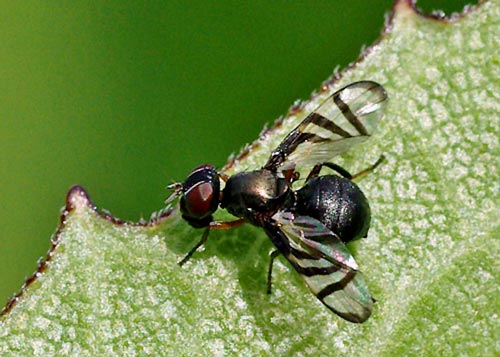Howdy, BugFans,
Signal Fly
The BugLady had to troll through several families of obscure flies (picture-winged flies, family Ulidiidae/Otitidae and true fruit flies, Tephritidae, before discovering the ID of these small beauties. They are Signal flies in the family Platystomatidae, in the genus Rivellia. According to Bugguide, Rivilli is Italian for declarations; the term refers to medieval census records, and the genus name may be a nod to the graphic markings on the fly’s wings. There are some 40 species of signal fly in North America (with many more in the tropics) and 34 of those 40 are in the genus Rivellia.
[metaslider id=4507]
SFs are usually seen in fields and edges. According to Wikipedia, “Adults are found on tree trunks and foliage and are attracted to flowers, decaying fruit, excrement, sweat, and decomposing snails. Larvae are found on fresh and in decaying vegetation, carrion, human corpses, and root nodules.” Well, they are flies.
SFs are small—these guys/gals are about 6mm long, with patterns on their wings and often on their faces and with metallic colors elsewhere. SFs have protruding mouthparts that resemble a gas mask: Tiny red fly—Rivellia inaequata. One branch of the family, the stalk-eyed flies, is exactly that—the bizarre eyes and protuberances on the legs are used in aggressive displays having to do with courtship.
What are they signaling? SFs strut and wave their wings during courtship (for a video of a fly in action, see “Signal Fly (Platystomatidae: Rivellia) on Leaf“). After their brief courtship (he may feed her droplets of clear, regurgitated liquid while mating), the female lays her eggs on plants, mostly Legumes.
Signal Fly Cycles
Quick and dirty high school biology detour. The BugLady confesses that she struggled with chemistry and with the various “cycles” (she knows that the cycles support the whole organisms, but give her a whole organism any day of the week). Nitrogen is vital to the life/growth of all living things (it’s a component of amino acids, DNA and RNA, for starters). While there’s plenty of nitrogen around, it’s often in an unusable form. Nitrogen is so important that it’s called a “primary limiting factor.” No accessible nitrogen—no plants. No plants—no animals. Simple and linear. Nitrogen becomes usable when it’s “fixed”—combined with hydrogen or oxygen to form ammonium or nitrate (How am I doing, Mr. Benton?). Some plants, especially the legumes, are called “nitrogen-fixing” plants; certain soil bacteria living in nodules on the plant roots accumulate and transform the nitrogen. The nitrogen feeds the plant and the plant feeds the bacteria. When a plant dies, other bacteria assist in decomposition, releasing the stash of nitrogen to nearby plants.
When the SF eggs hatch, the maggots of many species head for the nitrogen-fixing nodules on roots and chew their way in (the larvae of other species are saprophagus, feeding on decomposing plants or animals). Once inside, SF larvae feed on (and damage) the root nodules, inadvertently crippling the nitrogen-fixing factory. A big population of SF larvae could affect plant growth, but they are only listed as “minor crop pests.” The recent proliferation of soybeans is probably manna from heaven for them.
Adults have the typical vacuum cleaner mouthparts of a fly. Male SFs eat carbs in the form of rotting fruit, nectar, and honeydew produced by aphids and leafhoppers. Females eat carbs, but they also need protein from carrion (including dead insects), bird droppings or frass (insect poop) to support their reproductive activity.
The first thing you notice about the Rivellia pictures in bugguide.net is that they’re identified only to genus. The rear end of the male needs to be dissected in order to get a positive ID of some species. It looks like there are at least two species here. The all-black signal fly is (possibly) either Rivellia viridulans or R. melliginis (which is associated with Black Locust); R. viridulans is more common. The fly with the black thorax and red and black abdomen may be Rivellia colei or quadrifasciata (the soybean nodule fly); R. quadrifasciata, is the more common and widespread of those two species.
Celebrate the tiny creatures.
The BugLady
